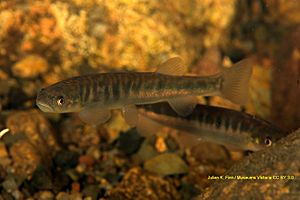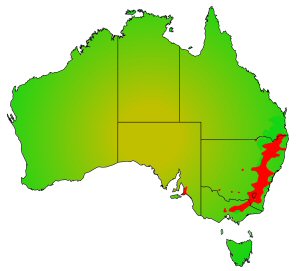Mountain galaxias facts for kids
Quick facts for kids Mountain galaxias |
|
|---|---|
 |
|
| Galaxias olidus | |
| Conservation status | |
| Scientific classification | |
| Kingdom: | |
| Phylum: | |
| Class: | |
| Order: |
Osmeriformes
|
| Family: | |
| Subfamily: | |
| Genus: |
Galaxias
|
| Species: |
G. olidus
|
| Binomial name | |
| Galaxias olidus Günther, 1866
|
|
| Synonyms | |
|
Galaxias bongbong Macleay, 1881 |
|
The mountain galaxias (scientific name: Galaxias olidus) is a type of freshwater fish. It is found in many rivers and streams across southeastern Australia. This fish is part of a larger group of similar fish species called a "species complex."
Contents
Description
The mountain galaxias has a long, tube-shaped body. It usually grows to be about 5.5 to 8 centimeters (2 to 3 inches) long. Some can even reach up to 12.6 centimeters (5 inches). Its body is gently curved on the top and bottom. The top part is a bit flatter before its pelvic fins.
Body Shape and Head
This fish has a medium-sized head. It is wider than it is deep and looks a bit like a wedge from the side. Its mouth is also medium-sized. The top lip is usually level with the middle of its eye. From there, it goes down and back towards the belly.
Colors and Patterns
Mountain galaxias fish come in many different colors and patterns. However, fish from the same area usually look similar. Their main color is often tan, light brown, brown, or olive green. Sometimes they can even be orange-brown. This color covers their head and snout. It gets lighter below their lateral line (a special line of sensory organs on fish). Their belly is usually cream or almost white.
On top of their main color, they have dark markings. These can be spots, blotches, or bands. Sometimes these markings join together to form irregular vertical stripes. In some groups of fish, these patterns might be very light or even missing. They might also have tiny grey spots that create a shaded look.
Often, you can see dark, oval-shaped bars along their sides. If these bars are present, they are usually thin and close together. They are also more varied in shape than those on the Barred galaxias. These markings usually extend far back along the body, at least to the anal fin.
Fins
The fins of the mountain galaxias have fleshy bases. Their pectoral fins (on the sides) are medium-sized and shaped like paddles. They are set low on the body. The pelvic fins (on the belly) are also low and are located about halfway along the body. The anal fin (near the tail on the bottom) is medium-sized. The dorsal fin (on the back) is about 90 percent the size of the anal fin. The tail fin is medium length and has well-developed edges that often reach as far forward as the anal fin.
Distribution
The mountain galaxias lives in a very large area of Australia. You can find it on both sides of the Great Dividing Range. This includes southern Queensland, eastern New South Wales, most of Victoria, and even west to the Adelaide Hills in South Australia.
This means they live in both the Murray–Darling basin and in rivers that flow to the eastern and southern coasts. Scientists are still learning how much of their coastal spread is natural. Some of it is due to "river capture" events, where rivers change course. Also, many fish in this group can "climb" over natural barriers like waterfalls using special pelvic fins.
Within the Murray-Darling river system, mountain galaxias usually live in the higher, cooler parts of rivers. Another fish, the flathead galaxias, is found in the lower, warmer parts. However, mountain galaxias sometimes go down into the areas where the high and low parts of rivers meet, especially in South Australia. Many other fish in this group only live in the upper parts of their rivers.
Habitat
Mountain galaxias live in many different freshwater places. You can find them at both low and high elevations. They live in rivers that are 4 to 20 meters (13 to 65 feet) wide. These rivers can flow slowly or moderately, and be clear or cloudy. They also live in small to medium creeks, about 0.5 to 5 meters (1.6 to 16 feet) wide, which can flow moderately or fast.
You might also find them in some wetlands, billabongs (small lakes), and farm dams in Victoria and central to northern New South Wales. They can also live in some upland lakes and pools that remain in drying rivers.
Where They Hide
Generally, these fish are found in shallow, fast-flowing areas called riffle zones. They also live in medium-depth runs. If there are predators around, they often hide in deeper pools, about 0.3 to 1.2 meters (1 to 4 feet) deep. They usually stay near the bottom of the stream. They like to hide among thick water plants, rocks, fallen wood, or under banks. Sometimes they swim in the middle of the stream, but usually only in places where there are no predators.
Cold Habitats
In the high parts of the Great Dividing Range, mountain galaxias live in streams that are covered in snow for part of the winter. Especially in Victoria and southern New South Wales, above the snow line, these fish live in streams that freeze over and are covered by snow for two to three months.
Lifecycle/Reproduction
The mountain galaxias lives its entire life in freshwater. It does not travel downstream to the sea or to salty water. In the upper parts of some streams, it might be the only fish species present. But in lower areas, it is often found with many other fish and crustaceans. These can include freshwater shrimp, prawns, and crayfish.
The time when mountain galaxias lay their eggs (spawn) changes depending on where they live. In South Australia, they spawn from early May to June. In Victoria and southern New South Wales, it's from May to August. In northern New South Wales and southern Queensland, they spawn later, from August to October.
Conservation
The mountain galaxias is currently listed as "Least Concern" for conservation. This means it is not considered to be at risk of extinction.
Utility to humans
These fish are generally not a target for fishing because of their small size. However, they can be fun to catch if you use very light fishing gear or a fly rod.



